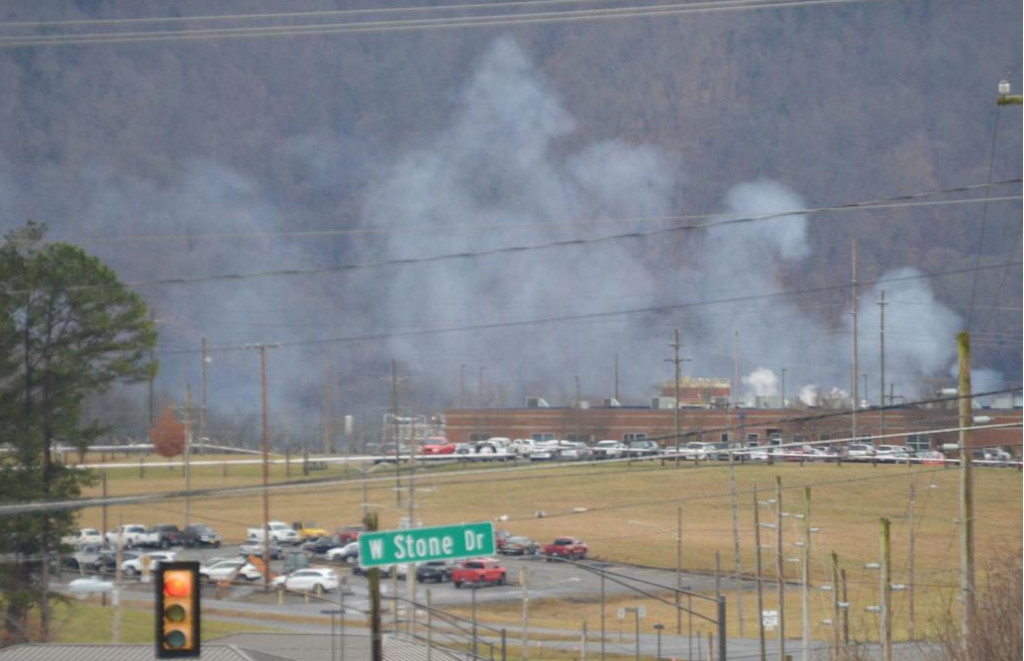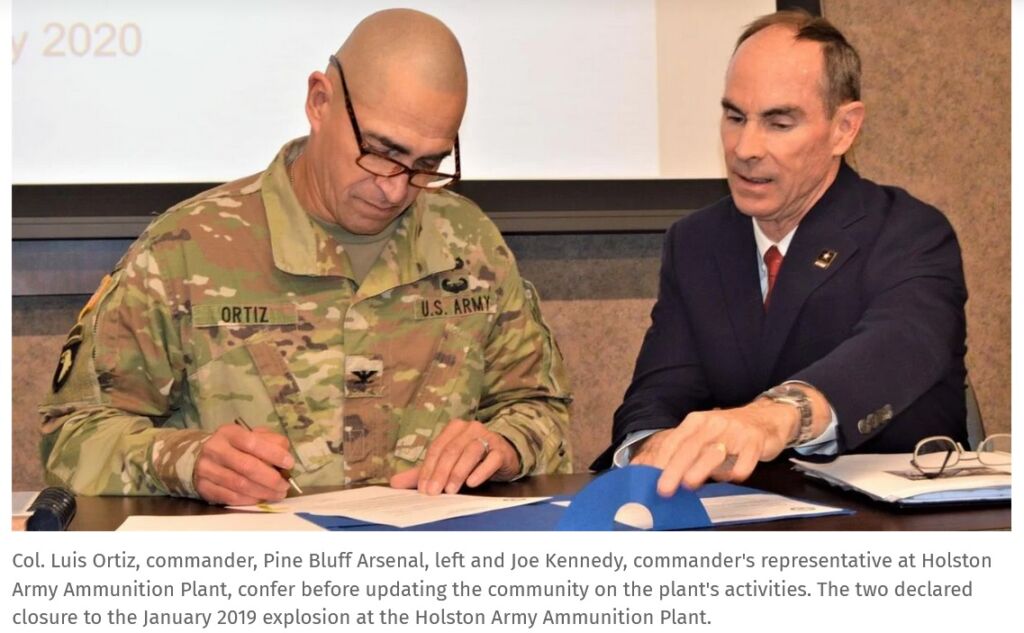
More smoke emits from the area of Thursday morning’s fire after a powerful explosion at the site shortly before noon on January 3, 2019.
By TESSA WORLEY tworley@timesnews.net, Kingsport Times-News
TENNESSEE — BAE Systems employees might not have followed safety protocols, which led to the Jan. 3, 2019, explosion at Holston Army Ammunition Plant, according to a lawsuit filed in federal court.
Terry Armstrong, who was the BAE Systems safety manager at the time of the incident, filed a wrongful termination suit in the U.S. District Court for the Eastern District of Tennessee at Greeneville against his former employer, the Army’s contractor at HSAAP, on July 19, 2019.
The lawsuit states that Armstrong was fired and made a scapegoat because of his actions with a water cannon.
In the lawsuit, Armstrong describes the fire, the events preceding the explosion and what happened afterward. He also provides details about what might have caused the fire.
HSAAP’s explanation of incident
After the 2019 explosion, ammunitions plant officials provided the public with information about what happened.
According to Justine Barati, chief of Public and Congressional Affairs for the Joint Munitions Command, a manufacturing building caught fire and spread to a trailer carrying explosives.
“On January 3, 2019, a fire in a manufacturing building triggered the sprinkler system,” Barati said. “The asphalt and shingles above the sprinkler system also caught fire. A plywood and steel trailer was parked under an overhang of the building, and the trailer was carrying 2,500 lbs. of explosives. The trailer caught fire, and some of the explosives detonated, destroying the trailer. The explosion blew out the fire that was on the roof of the building, but burning trailer debris caught the wooden barricades around the building on fire.”
Barati said they then conducted a controlled burn because it isn’t safe to fight chemical fires.
“The fire was allowed to burn itself out since that was safer than putting the lives of firemen in danger to protect a building,” Barati said. “The fire was monitored as it burnt itself out, and monitoring a fire is called a controlled burn.”
Barati said they never determined the actual cause of the explosion. Still, investigators at the time said it could have something to do with how many explosives were in the trailer.
“The root cause of the explosion was impossible to determine,” Barati said. “Investigators did note possible issues with an isolated quantity of explosive product and apparent conflicting or lack of guidance concerning manufacturing instructions and Standard Operating Procedures on site.”
Barati said that after the fire, BAE Systems made changes to its policies and implanted more safety procedures.
“The health and safety of our workforce and community is our top priority,” Barati said. “The operating contractor implemented additional safety measures and addressed the Standard Operating Procedures to ensure clear written guidance and proper notifications if something out of the ordinary occurs.”
Barati said that the policies in place then had to be made clearer.
“At the time, we experienced an event that had never happened before, and our policies didn’t directly tell employees what to do,” Barati said. “Any policy can be interpreted, so [after the fire] our policies needed to be clarified.”
BAE Systems Director of Communications Claire Powell, said that the investigations following the fire resulted in policy changes and training.
“There was an internal after-action report that can’t be released for matters of national security, but the report supplemented our investigation,” Powell said. “We made a lot of changes in response to the investigations.”
According to the lawsuit, on the day in question, Armstrong was contacted by several people who said a building on HSAAP property had caught on fire.
“[Armstrong] was informed by BAE agents and employees that explosives had been delivered to the building the night before and employees had noticed smoke coming from the building,” the lawsuit states. “A tractor-trailer loaded with 2,700 pounds of explosives was backed up to the loading dock.”
Once Armstrong reached the plant, he met with several high-level officials to discuss their options. According to the lawsuit, they discussed things like moving the trailer away from the loading dock.
Armstrong mentions in the lawsuit that he took drone photos of the fire.
According to the lawsuit, government safety representative Gene Faxon suggested placing a water cannon near the fire for monitoring, which Armstrong did. Armstrong adds that he remained on the property for an additional 16 hours.
The lawsuit states that Armstrong was informed that the building where the fire had started was filled with explosives, which were too hot.
“While at HSAAP on January 3, 2019, [Armstrong] was advised and informed that the rising temperatures of the RDX-based explosives which had been manufactured by BAE and stored for shipment in Building N-8 had not been reported to the safety department,” the lawsuit states. “BAE and Army protocols require that the manufacturing and operational staff and supervisors immediately notify BAE’s safety department staff of manufactured explosives’ rising temperatures. Instead, BAE’s operational supervision and staff withheld the critical information of a temperature increase from BAE and Army safety personnel. BAE operational and quality control staff visited Building N-8 at approximately 7 a.m. on the morning of January 3, 2019, to check the overheated explosives when they observed that the Building N-8 was on fire.”
Armstrong also says he was informed that employees did not follow procedures which could have prevented the situation.
“The plaintiff avers that when the temperature of RDX-based explosives significantly exceeds its ‘safe’ temperature, the explosives can spontaneously combust,” the lawsuit states. “Had the BAE safety department staff been advised of the RDX-based explosives’ rising temperatures during the shift before the discovery of the building fire, [Armstrong] and/or his staff would have insisted that the explosives be ‘put underwater’ to lower their temperature and lessen the risk of a spontaneous explosion. Had BAE operational supervisors and staff reported the explosives’ rising temperatures as required by all applicable safety protocols, the RDX-explosive material could have been cooled safely. Once put under water, the explosive material would then have to be ‘reprocessed’ and re-manufactured into new packs of explosives.”
According to Armstrong’s statements in the lawsuit, the fire was caused by over-heated explosives, which spontaneously combusted because staff ignored protocol by not notifying the safety department prior to the fire.
The lawsuit states that 800 pounds of the 2,700 pounds of explosives stored at the loading dock detonated during the fire.
Claims about how the explosives were handled before the fire has not been confirmed by any official staff at HSAAP.
The lawsuit states that HSAAP conducted an investigation and reported its findings to several entities, including the FBI, OSHA and the Army Safety and Fire Marshal offices.
The lawsuit was dismissed Nov. 24, 2020 due to the plaintiff’s failure to state a claim.

Armstrong started a new job in April 2020, working for the federal government as a safety specialist at HSAAP.
The Times-News has attempted to reach Armstrong’s attorney by phone several times. The staff has also unsuccessfully attempted to reach Armstrong for comment.
Times-News files FOIA request
The Times-News is working to obtain additional information about the investigation of the fire.
The newspaper submitted a Freedom of Information Act request to the Joint Munitions Command for a safety report document.
The Times News requested an expedited response. FOIA law states that agencies must decide whether to grant the expedited response.
HSAAP officials have not responded with any information other than confirming that they received the FOIA request.
Kingsport Times-News Publisher Rick Thomason said the newspaper will continue to seek records from HSAAP that are in the public’s interest.
“We will continue to pursue this story as it is a matter of not only public interest but also public safety and public health,” Thomason said. “After- action reports, shakedown reports or whatever you want to call them are protocol after incidents such as these. In our view, those reports should be made available for public scrutiny. While we understand potential national security concerns at Holston, we also are bound to inform our communities of the dangers of mishaps at such facilities. The public doesn’t necessarily need to know what explosives were involved in the explosion unless they presented a health hazard to the surrounding community. But the public deserves to know what, if any, hazards the explosion did present, what led to the explosion, how it was handled onsite and what new measures are in place to prevent another such occurrence. A good community steward will offer those explanations without fear. That’s all we, and the surrounding community, ask.”
Paul McAdoo, a lawyer for the Reporters Committee for Freedom of the Press, explained the appeal process for a denied FOIA request.
“If a FOIA request is denied, the requester typically has 90 days to submit an administrative appeal to the agency,” McAdoo said. “If the administrative appeal is also denied, the requester then can file suit either in their home federal jurisdiction, like the Eastern District of Tennessee or in the District Court for the District of Columbia.”
Lawsuit Armstrong BAE Holston Army Fire Explosion 2022
